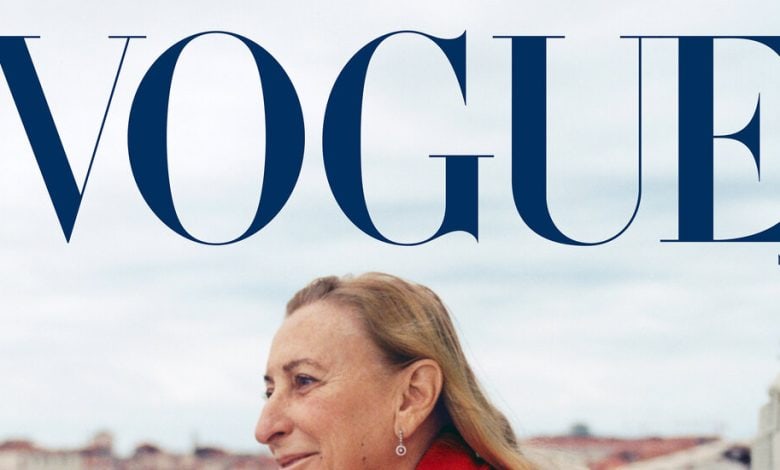Mrs. Prada on Vogue, a Revelation

Throughout Vogue’s history, its typical cover stars have included a parade of youthful beauties: models, actresses, celebrities, the occasional stunning athlete and, once in a while, a politician or first lady — all glammed to the max.
Cover models serve as portals into a world of ideas about how women should look and dress, what Vogue represents and the magazine’s concept of the modern woman. Almost always, the models look at the camera, making contact with us, inviting us in. They are posed, buffed, polished and embellished to a level of poreless perfection well beyond the realm of regular mortals. The cover model embodies a glossy, aspirational and commercial glamour — the “lifestyle” that is Vogue’s stock in trade. However talented or interesting she may be, she is also, always, a commodity.
The photograph of Miuccia Prada, taken by Stef Mitchell, on the cover of this month’s American Vogue defies all of these conventions. She is not a model, an actress or an elected official. She’s not really even a celebrity since, despite her fame and iconic status, she tends to eschew the spotlight. “We knew the cover would take some persuasion,” explained Anna Wintour in an email. “Mrs. Prada has long put her work forward much more than herself.”
What’s more, at 74, Mrs. Prada is well beyond the age of nearly all Vogue cover subjects, who only rarely stray north of 50 (if they are, say, former ’90s supermodels), and virtually never beyond 60. A quick perusal of the past 10 years of covers reveals Jill Biden and Meryl Streep, who posed at 70 and 68, as the only women in that category, but they were lit and made up in the expected, glamorizing way.
Mrs. Prada here looks youthful and vibrant, but her photo seems utterly unconcerned with primping or dissembling age. Her long, reddish-gold hair is tucked simply behind her ear, some stray flyaways visible. She seems to be wearing almost no makeup at all, allowing us to see the normally unseeable: the natural texture of her skin, its freckles, a mole, the lines around her mouth and eyes. In any other context, those details would be unexceptional, everyday sights. On a Vogue cover, they read as fresh and arresting, tiny hand grenades tossed into the status quo.
Even more startlingly, unlike over 95 percent of Vogue cover models in the last decade, Mrs. Prada is not looking at the camera, or even facing forward. Instead, we catch her in profile, leaning on the stone balcony of the 18th-century Baroque palazzo that houses her Fondazione Prada in Venice, the institute of contemporary culture she founded with her husband in 1993. She gazes outward over the Grand Canal, but her expression is introspective, almost dreamy.
